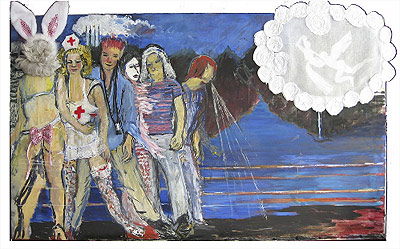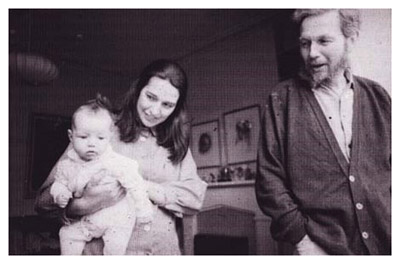
| HOME |
| NERVE |
| REVIEWS |
| ARCHIVE |
| EVENTS |
| LINKS |
| ABOUT US |
| CONTRIBUTORS |
| BACK ISSUES |
| CONTACT US |
 Frances
Conway-Seymour Profile
Frances
Conway-Seymour Profile
By Gayna Rose Madder 15/7/2010
Earlier this year, lifelong and well-known artist Frances Conway-Seymour was told she had only weeks to live.
This was later extended to months; no-one knows how many But thankfully she is still here for the moment; and the only good news about the situation is that she has been prompted to mount a retrospective exhibition of part of the vast body of work she has produced over some decades, from 1954 to the present.
Frances painted and drew from when she was very young, asked to produce artworks for other schoolchildren. But, as a war child who left school at fourteen, her lack of qualifications meant she was unable to obtain the grant need to attend art college, and worked in offices without ever giving up her main ambition.
Finally, at twenty-two she was admitted to the West England College of Art on the strength of drawings she had produced at evening classes. In the painting school she met head of department George Sweet, with whom she became friends until his death in 1998. A strict teacher of Fine Art, he encouraged hard work.
At twenty-five she married lecturer Robert Hurdle, leaving before completing the course to have first son Timothy.
Long before the days of crèches, she soon had second son Ben, and her limited opportunities to paint during this period produced the work based on some of her greatest inspirations - the seascapes and farmland of Dorset, portraits of her family, and domestic subjects. James Belsey, the Bristol Evening Post art critic, described her as a 'domestic painter' during her 1974 Bristol exhibition, for which event another art critic, Helen Reid, made her 'Woman of the Week'.
As family holidays moved from Dorset to Wales, so did the subjects of her paintings. Voted to become a 'Royal West-of-England Academy' member at twenty-nine, she was invited to show in each of the Galeries Volombreuse in Biarritz and Paris, as well as exhibiting regularly locally.
By this time her favourite subjects were eclectic and the next period of her work found her moving from oil on canvas as her main medium to water and body colour, conté, pencil and collage. She had earlier utilised the latter in her realist work of the 1950s and 1960s, which dealt with difficult political situations such as the civil rights movement, the Sharpeville massacre in South Africa, as well as the Warsaw ghetto and Mata Hari. These works - some of which are quite large - were mainly painted but used children's drawings, press cuttings and even Polyfilla.
 Frances
has led an eventful life. She describes Robert Hurdle (see photo left),
her second husband and father of her first three children, as a good companion
in her life. She then met and married writer/farmer John Seymour, whom
she describes as a pertinent influence and ahead of his time in that,
some decades ago, he was examining issues such as global warming. But
she describes her time with him as being “psychologically too much”
and so she left.
Frances
has led an eventful life. She describes Robert Hurdle (see photo left),
her second husband and father of her first three children, as a good companion
in her life. She then met and married writer/farmer John Seymour, whom
she describes as a pertinent influence and ahead of his time in that,
some decades ago, he was examining issues such as global warming. But
she describes her time with him as being “psychologically too much”
and so she left.
This artist has always been ahead of her time. Long before feminism became a daily term, she found a way to combine an outwardly traditional family role as a wife and mother with political radicalism, some major achievements as an artist, and the legacy of a huge and eclectic collection of her work. The second part of Frances' retrospective exhibition, comprising entirely different works, will be on show later this year at Lark Lane Atelier 1.
Her terminal illness is inoperable, but she is pleased to have completed the 'Elizabeth Willow' series just before being diagnosed last Spring, as these now comprise some of her favourite pieces of her own work, which also include 'Mata Hari', Birth of Venus', and 'Feast of Dionysius or Hen Party' (see above). The extensive exhibition continues at the Lark Lane Atelier (upstairs), and another section opens at Lark Lane Atelier 2 on 24th July.
Frances Seymour 79, died on the 25th September 2010 at 5.30pm, she passed away peacefully in her sleep.